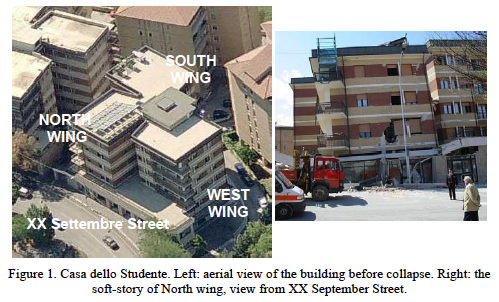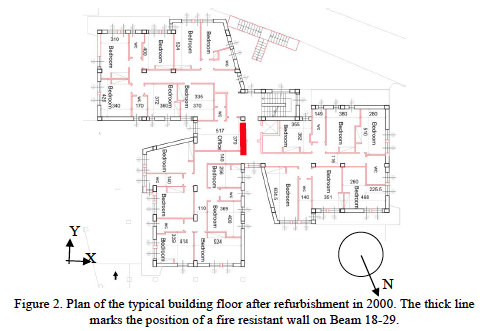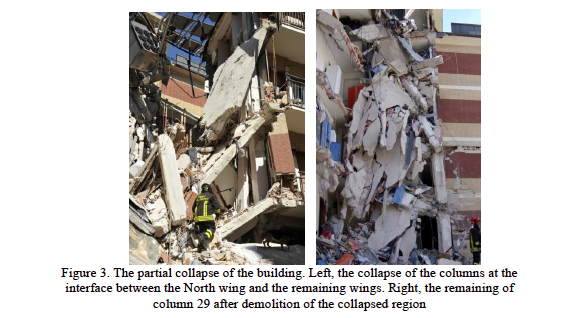NUMERICAL SIMULATION OF SEISMIC COLLAPSE OF ARC FRAMED BUILDING: A CASE STUDY
The paper investigates the partial collapse (during the April 6, 2009 earthquake of L’Aquila, Italy), of a seven-story reinforced concrete building designed in 1965.
The three-wing building underwent a partial collapse in one of them. Within the affected wing, two collapse mechanisms developed, one in a horizontal plane and the other in vertical direction. The former was a soft/weak story mechanism at the ground floor, the latter involved the failure of three columns (and of the supported beams) at all the levels from the ground floor to the roof. Casualties are all due to this second mechanism, as nobody was trapped in the soft-story collapse. The three columns were located at the interface with the remaining building, in the zone undergoing a severe distortion because of the dramatic difference in vertical displacements due to the soft–story mechanism. At levels from 1 to 4, one of the columns was supporting a beam that was in turn carrying, on half of its span, a non-structural wall added during a refurbishment work. The beam failed in shear, approximately at midspan, at the end cross-section of the wall. A previous study, based on linear analyses only, showed that the lack of flexural strength of ground story columns was the main cause of the collapse. Through non-linear static analyses, the paper investigates the collapse sequence and the role played by the non-structural wall (and by the related shear failure of beams). A refined numerical model of the structure, including the reinforcement layout, has been developed to find the reasons for the disproportionate effects that the partial softstory collapse had. The results clarify the role of the added wall and of the lack of beam shear strength on the collapse of the three columns.
1. INTRODUCTION
On April 6th 2009 at 3.32 am a magnitude Mw 6.3 earthquake struck the city of L’Aquila (Central Italy) and the surrounding area, causing the collapse of several reinforced concrete (RC) buildings in the urban area [1]. Among them, the building named “Casa dello Studente” (CdS, in the following), at about 6 km from the epicenter, suffered a partial but severe collapse, with a high death toll of eight students.
The seven-story RC building, depicted in Figure 1 left, was hosting a University dorm (“Casa dello Studente” means Student House, in Italian). However, the building was initially designed in 1965, following the Italian Seismic Codes of 1937 [2] and 1962 [3], for a residential/commercial mixed use. The plan of the residential part, in the upper four stories, was subdivided in three wings, connected through the stairwell, with an apartment in each wing. Ground floor and basement, common to all the wings, were originally designed for offices and laboratories of a pharmaceutical company. A second, non-residential, underground level was present only below the South wing.
In 1979, a University Institution bought the building with the intention of using it as a student house. The residential part of the building remained unchanged, while a minor refurbishment work took place at the ground floor and at the two underground floors, to locate offices, a library and a cafeteria for students. In 1982, without any modification to this configuration, the building became property of the Abruzzo Region, in force of State and Region Laws. During the years 1999- 2002, a wide refurbishment intervention took place, not covering the structural system, to transform the layout of the upper floors and to make the building more apt to its actual usage (Figure 2).


The refurbishment works were performed without any assessment on the structural system, even though almost 30 years had passed since the initial design, and meanwhile the knowledge on earthquake engineering had dramatically increased. In addition, a non-structural, fire-resistant wall (denoted, from the French acronym, as “REI wall” in the following) composed of lightweight concrete hollow blocks, was placed at floors from the first to the fourth (thick red line in Figure 2). The wall, intended to partition the stairs from the remaining building, was supported by, but not connected to, the underlying beams.
The partial collapse of the building was limited to the North wing (Figure 1).
Within this wing, two separate collapse zones could be recognized, from both pictures of the collapsed part and on-site observations. All the columns at the ground floor failed with a soft/weak story mechanism (Figure 1 right). In addition, three columns (#21, 25 and 29 in Figure 4) failed along the height of the building, at the interface between the North wing and the remaining ones (Figure 3).
Previous studies [3, 4], performed for legal reasons, showed that neither the poor quality of material properties nor the ground motion at the building site could be considered – from the Italian laws viewpoint – among the causes of the collapse.
The results of linear analyses showed that the building would have collapsed even if the concrete had had the properties adopted in design. If the average inherent ductility of old RC framed buildings and the different design approach (working stress instead of partial coefficients and limit states) are considered, the prescriptions of the Italian Seismic Code of 1962 appear sufficient to prevent collapse and justify the fact that the wide majority of RC buildings of comparable age survived the earthquake.

The most likely collapse sequence was established by crossing the design criteria adopted in 1965, the results of modal analyses of the building in its original configuration and after refurbishment, and all the experimental data coming from the analysis of damage in the parts of the building that survived the earthquake. A design error and a non-conformity with design configuration inserted during construction resulted in a severe lack of flexural strength of ground story columns; this appeared to be the main cause of the collapse. However, the questions whether the two collapse mechanisms were independent, and about their time sequence, remained open.
In this work, starting from the previous findings, the collapse sequence has been investigated. A complete and refined numerical model has been derived, based on the availability of data on the reinforcement geometry. Non-linear static analyses are performed to compute the capacity curve of the structure, with the aim of clarifying whether the collapse mechanism of columns 21, 25 and 29 was a disproportioned effect of the partial soft-story collapse at ground floor or an independent mechanism. Section 2 describes the building structure and the modifications brought by refurbishment work. Section 3 presents the earthquake characteristics. The numerical model adopted in non-linear analyses is described in Section 4; the results are discussed in Section 5. Conclusions in Section 6 address not only the collapse sequence but also the chance of avoiding the loss of human lives.
Tratto dal Volume: STUDIES AND RESEARCHES – V.34, Graduate School in Concrete Structures – Fratelli Pesenti Politecnico di Milano, Italy
